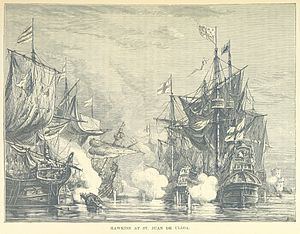Date 23 September 1568 | Result Spanish victory | |
 | ||
Francisco LujánJuan de Ubilla John HawkinsFrancis Drake 1 galleon sunk1 galleon damaged20 dead Combatants Spain, Spanish Empire, Kingdom of England Similar Battle of Blaye, Battle of Castlehaven, 2nd Spanish Armada, Battle of Pantelleria (1586), Azores Voyage of 1589 | ||
The Battle of San Juan de Ulúa was a battle between English privateers and Spanish forces at San Juan de Ulúa (in modern Veracruz). It marked the end of the campaign carried out by an English flotilla of six ships that had systematically conducted illegal trade in the Caribbean Sea, including the slave trade, imposing it even by force.
Contents
Context
The English fleet consisted of 5 ships: the Royal carracks Jesus of Lübeck (leased from Queen Elizabeth I) under John Hawkins, the Minion under John Hampton, and the barques Judith under Hawkins' cousin Francis Drake, Angel and Swallow. A captured Portuguese caravel joined the privateers near the coast of Ghana, where the English competed with Portuguese slave traders. The ship was renamed Grace of God. A seventh ship, the barque William and John, sailed back home before the battle, but after reaching Ireland on February 1569, she was lost with all hands on her way back to England. Following a full year of plundering and illegal trading, Hawkins decided to anchor his ships in the port of San Juan de Ulúa on 15 September for repairs and resupply before the return voyage to England. But while they were carrying out this reprovisioning, a Spanish escort fleet under command of Don Francisco Luján also arrived in the port.
Battle
Initially the English did not fear for their safety, since they had on board several hostages who had confused the English fleet for a Spanish one, and so at first arrived at an accord with Viceroy Martín Enríquez de Almanza. The English had repeatedly broken the peace by attacking unarmed merchant shipping but at this point they believed the Spanish would respect a truce on this occasion. However, Luján had been informed of the English fleet's activities and, after many attempts at an accord, he launched a lightning attack on them in which the English lost 4 ships and 500 men as well as almost all of their year's loot, which was re-captured by the Spanish. Luján's fleet lost the vice-admiral ship, the galleon Santa Clara, which burnt and sunk inside the port. The flagship San Pedro, the only full-armed Spanish ship at San Juan, was also badly hit during an exchange of fire with Minion, which also suffered damage. The early assault and capture of the island's batteries—held until then by the English—by a Spanish pinnace, commanded by a Captain Delgadillo, became decisive to the fate of the English fleet. Angel sank after a few salvoes, and Swallow was seized by the Spaniards soldiers manning the batteries. The French commander of the Grace of God, Robert Blondel, set her on fire before joining Hawkins on board the Jesus. Both of them, along with some members of the crew of the Jesus were later rescued by a pinnace after Hawkins gave the order to abandon the ship. Hawkins took command then of the Minion.
Only the Judith, commanded by Drake, and Minion escaped, whilst battle was still raging on, leaving behind them the Jesus of Lübeck and some members of her crew still on board. The surviving vessels sailed out when two ships on fire were driven on them by the Spanish. The Englishmen feared a fire ship attack. The Jesus was eventually boarded by a Spanish party who had been lurking inside a nearby hulk, the San Salvador, under the command of Captain Juan de Ubilla. A first Spanish attempt had been beaten off by Hawkins' crew, not before suffering some dead and injured. There are allegations that Ubilla allowed his men to loot the booty left on board the Jesus by Hawkins.
Aftermath
During their withdrawal, the Minion and the Judith were hopelessly overcrowded, and some of their men had to be abandoned on what is now the southern coast of the United States to save on supplies for the Atlantic crossing. Hawkins left behind 110 men to surrender to the Spanish. He eventually arrived back in England with a crew of only 15. Drake had reached Plymouth just days before, on 20 January 1569. Only 70 or 80 sailors from the original expedition returned to England at all.
While Hawkins accused the Spaniards of treason for not honouring the truce, Almanza's only intention was to hold his authority and the Spanish monopoly in West Indies.
The battle was a clear precursor of the war that broke out between Philip II of Spain and Elizabeth I of England in 1585.
